The State Library
of South Australia has the largest collection of wine literature
in the southern hemisphere and one of the biggest in the world.
Its origins date back to 1834, two years before the first European
settlers arrived in the colony. The collection ranges from an
eleventh century manuscript leaf to recently published books and
magazines, to wine labels, wine lists and diaries of winemakers,
and to books in many languages. This theme features twelve of
the State Library’s most precious wine records.
Punishments
for drunk monks 1000 years ago
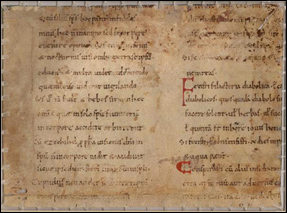 Decretum. By
Burchard of Worms
Germany, first half of the eleventh century. Decretum. By
Burchard of Worms
Germany, first half of the eleventh century.
This is part of a manuscript leaf
from a manual for the instruction and guidance of young monks, written
in a German monastery a thousand years ago. The language is Latin
and the script Carolingian, on which is based some of the most beautiful
printing types still in use today. It contains punishments for drunk
monks - fifteen days on bread and water if one drank so much that
one vomited; thirty days on bread and water if one, when drunk,
encouraged others to get drunk; and forty days on bread and water
if, through drunkenness, one vomited the communion wine and sacred
host.
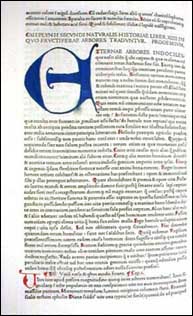 Wine
in the classical world and a classic of
printing Wine
in the classical world and a classic of
printing
Pliny’s Natural
history. Venice
1472.
The Library’s
oldest original printed book with winegrowing
references is this remarkable encyclopaedia
of the ancient world, which was the major
source for most mediaeval knowledge. Printed
in Venice in 1472 by the influential type
designer, printer, and publisher, Nicolaus
Jenson, some 17 years after the first book
was printed in Europe from moveable type,
this most handsome volume is full of information
on wine-growing in ancient times.
For
those who cannot read Latin, the following
is a translation.
Pliny’s Natural
history London: Bohn, 1855-1857,
vol.3
Wine
and prayer
Book
of hours. Paris, 1490.
Books of
Hours were the personal prayerbooks of
the laity and have been described as "late
mediaeval best-sellers". Those produced
by hand during the later Middle Ages and
the Renaissance were often elaborately
decorated, and might include beautiful
miniature pictures depicting the occupation
for each month of the calendar year: the
occupation usually chosen for March was
ploughing and pruning and for September
treading the grapes.
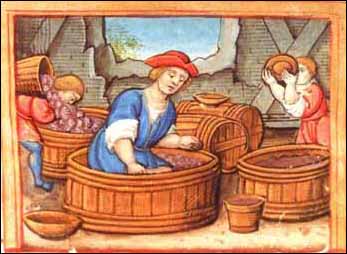
Book
of Hours. Paris, 1490. This
exquisitely illustrated work was written
and decorated by hand on vellum in
Paris in about 1490. Among its brilliantly
coloured miniatures is one for September,
which shows a person treading grapes.
In addition to the treader and someone
pouring grapes from a basket into a
vat, a worker in the background enjoys
a surreptitious tipple, adding a humorous
touch. It is on permanent loan to the
State Library of South Australia from
the Anglican Diocese of Adelaide.
The vivid
and richly detailed miniatures, which appeared
in the calendar of the Trés
riches heures du Duc de Berry, were
begun early and finished late in the fifteenth
century for Jean, Duc de Berry. The miniature
for March shows three peasants trimming
vines within an enclosure, with more vineyards
on the right. For September, we see the
grape harvest at the foot of the Château
de Saumur. The original book is in the
collection of the Musée Condé,
Chantilly.
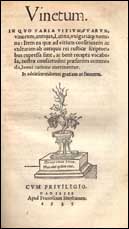 First
edition of the first wine book
Vinetum,
by Charles Estienne. Paris, 1537 First
edition of the first wine book
Vinetum,
by Charles Estienne. Paris, 1537
Although
Arnaldus de Villanova’s Liber
de vinis, published in 1478, is often
said to be the earliest printed book on
wine, it dealt mainly with the supposed
physical effects of wine, and its perceived
ability to cure poor memory, jaundice or
melancholy, rather than with winegrowing.
The earliest
book devoted to grapegrowing and winemaking
was Vinetum, by Charles Estienne,
first published in Paris in 1537 and republished
many times. Written in Latin, surprisingly
this landmark book has not been translated
into English. It includes a table of French
wines and wine regions, with their Latin
and French names, some of which – Beaune,
Beaujolais, Champagne, Bordeaux – are
clearly identifiable.
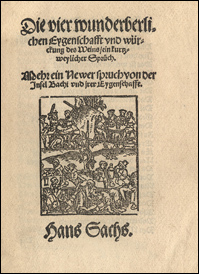 The
four wondrous properties of wine and
their effects The
four wondrous properties of wine and
their effects
Die
vier Wunderberlichen Eygenschafft und Wurckung des
Weins…, by Hans Sachs.
Nuremberg : Georg Merckel, 1553.
This very
scarce pamphlet describes "the four wondrous
properties of wine and their effects".
The opening paragraph, here translated
by Professor Ralph Elliott, gives an indication
of the tenor of this entertaining work:
One
day I asked a doctor to tell me whence
derives the power of wine to affect in
four different ways whomever it overcomes
so that his mood changes. The first he
makes peaceful, benevolent, mild and
kind. Others he arouses to anger, so
that they storm and quarrel and rage.
The third he makes crudely childish and
shameless, while the fourth is led by
the wine to fantasies and follies.
He
said, I will tell you. The wise pagans
describe how after the Flood had
passed, Lord Noah began to plant
vines before anything else. But the
soil was unfruitful, so old Noah
cleverly fertilized it with manure
which he took from different animals,
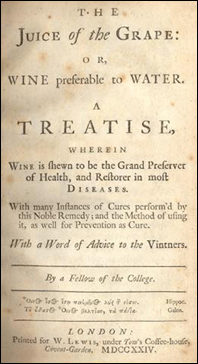 namely sheep, bears, pigs, and monkeys.
With this he manured his vineyard
all over, and when the wine was ready
it had acquired the natures of the
four animals, properties which it
still possesses. Now God made all
men of four elements, air, fire,
water, and earth, as Philosophy confirms,
and according to each man’s
nature, so does wine affect him. namely sheep, bears, pigs, and monkeys.
With this he manured his vineyard
all over, and when the wine was ready
it had acquired the natures of the
four animals, properties which it
still possesses. Now God made all
men of four elements, air, fire,
water, and earth, as Philosophy confirms,
and according to each man’s
nature, so does wine affect him.
Hans Sachs,
who died in Nuremberg in 1576, was a member of
the Meistersinger Guild, and the subject of Wagner’s
opera, The Mastersingers of Nuremberg.
Wine
cures gout
The
juice of the grape, by Dr. Peter Shaw.
London 1724.
Shaw, a
London physician, and an early advocate
of the medicinal benefits of wine, claims
that wine cures everything from smallpox
to venereal disease, including gout. This
copy, beautifully bound with its spine
and corners in calfskin, comes from the
library of the great twentieth-century
wine writer, André Simon, and contains
his elegant bookplate. Simon found the
work "very amusing".
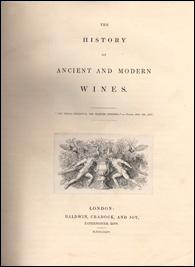 Finding
words to convey flavours Finding
words to convey flavours
The
history of ancient and modern wines, by
Alexander Henderson. London, 1824.
This is
probably the first book in the English
language to give anything like an accurate
account, based on some personal travelling,
of the wines of Europe and also of Persia
and the Cape of Good Hope. Henderson, a
doctor, describes a problem common to today’s
wine writers and consumers – how
to find words to convey flavours. Many
of his observations on "modern wines" are
still valid.
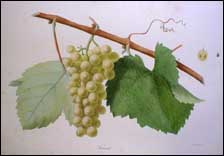 Grapes
have family histories, too Grapes
have family histories, too
Ampélographie
française, by Victor Rendu. Paris,
1857
Ampelographies
describe and often illustrate grape varieties.
The hand-coloured lithographs of Eugene
Grobon make this book possibly the most
prized of the great ampelographies of the
nineteenth and early twentieth centuries.
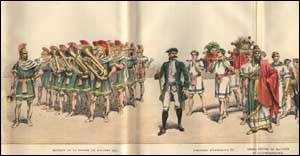 A fête worth waiting for A fête worth waiting for
Album
officiel de la Fête des Vignerons. Paris,
1889
One of
a rare and spectacular series of works
describing and illustrating the Fêtes
of the Vignerons of Vevey, which have been
held in the Swiss town of Vevey irregularly
since the mid-seventeenth century. They
are now held roughly once in a generation.
It is the world’s most important
wine festival, and is a development of
the activities of the mediaeval Wine-Growers’ Guild.
Each fête generates a number of sought-after
publications including a fold-out album,
or leporello, which could be up to seven
metres long. Vevey is on Lake Geneva between
Lausanne and Montreux. Chasselas is the
main grape variety grown, producing a dry,
robust white wine.
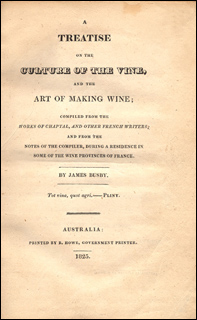 Australia's
first wine book Australia's
first wine book
A
treatise on the culture of the vine and the art of
making wine, by James Busby. Sydney, 1825
Australia’s
first wine book was written a year after
its 24-year old author arrived in New South
Wales. Based on the ideas of French writers
it was intended to show "the respectable
portion of the community" how to produce
wine and thus to give value to tracts of
land which otherwise "would in all probability
remain for ever useless". But Busby also
regarded viticulture as fitted "to increase
the comforts, and promote the morality
of the lower classes of the Colony" – a
theme which persists through much of Australia’s
nineteenth-century oenography. Busby also
predicted that wine would supply "the great
desideratum of a staple article of export,
to which the colonists of New South Wales
might be indebted for their future prosperity".
He is known as the father of Australian
viticulture.
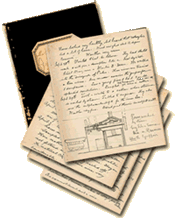 Leo
Buring's journal Leo
Buring's journal
Leo
Buring’s journal of a visit to the vineyards
and cellars of Germany and France in 1896.
Buring
spent time at Schloss Johanissberg and
at Geisenheim on the Rhine: the world-famous
wine school at Geisenheim had been founded
in 1872. Buring’s unpublished notes,
some in English, others in French, are
full of practical details, as well as occasional
impressions of wines tasted.
Valmai Hankel
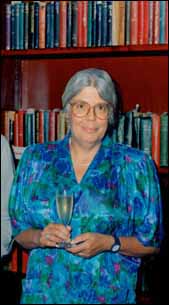 Valmai
Hankel was Senior Rare Books Librarian
at the State Library of South Australia
until she retired in June 2001, and has
a particular interest in the literature
of wine and its history. She even coined
a word, ‘Oenotypophily’, which
she takes to mean "love of wine and print" to
describe this obsession. Valmai
Hankel was Senior Rare Books Librarian
at the State Library of South Australia
until she retired in June 2001, and has
a particular interest in the literature
of wine and its history. She even coined
a word, ‘Oenotypophily’, which
she takes to mean "love of wine and print" to
describe this obsession.
She has
been wine writer for the monthly publication, The
Adelaide Review, since October 1995,
writes a column on wine history for the
national magazine, Winestate, and
has inaugurated an occasional column, "Oenotypophily",
for the magazine The Australian and
New Zealand Wine Industry Journal. She
firmly believes that wine books from the
past have much that is both relevant and
entertaining to say to us today, and spends
a fair bit of time in both writing and
public speaking trying to convince others
of this. The pamphlet, Oenography: words
on wine in the State Library of South Australia,
is believed to be the first publication
of the Australian Bureau of Statistics
not to contain a single statistic.
As well
as drinking more good wine than she should,
she has been an associate judge at South
Australia’s McLaren Vale Wine Show
on three occasions, and was chairman of
the consumer panel for the Advertiser-Hyatt
South Australian Wine of the Year Award
for five years. |


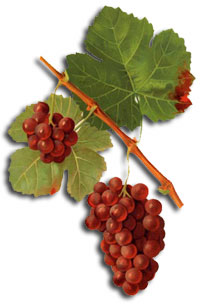

 Wine
in the classical world and a classic of
printing
Wine
in the classical world and a classic of
printing

 The
four wondrous properties of wine and
their effects
The
four wondrous properties of wine and
their effects namely sheep, bears, pigs, and monkeys.
With this he manured his vineyard
all over, and when the wine was ready
it had acquired the natures of the
four animals, properties which it
still possesses. Now God made all
men of four elements, air, fire,
water, and earth, as Philosophy confirms,
and according to each man’s
nature, so does wine affect him.
namely sheep, bears, pigs, and monkeys.
With this he manured his vineyard
all over, and when the wine was ready
it had acquired the natures of the
four animals, properties which it
still possesses. Now God made all
men of four elements, air, fire,
water, and earth, as Philosophy confirms,
and according to each man’s
nature, so does wine affect him.
 Finding
words to convey flavours
Finding
words to convey flavours Grapes
have family histories, too
Grapes
have family histories, too A fête worth waiting for
A fête worth waiting for
 Leo
Buring's journal
Leo
Buring's journal Valmai
Hankel was Senior Rare Books Librarian
at the State Library of South Australia
until she retired in June 2001, and has
a particular interest in the literature
of wine and its history. She even coined
a word, ‘Oenotypophily’, which
she takes to mean "love of wine and print" to
describe this obsession.
Valmai
Hankel was Senior Rare Books Librarian
at the State Library of South Australia
until she retired in June 2001, and has
a particular interest in the literature
of wine and its history. She even coined
a word, ‘Oenotypophily’, which
she takes to mean "love of wine and print" to
describe this obsession.